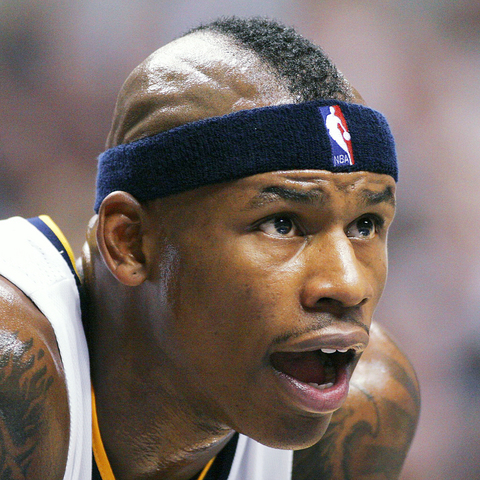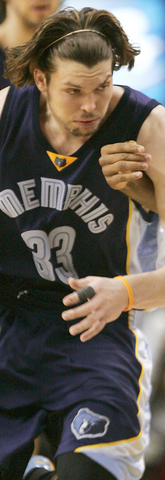Forget basketball. Michael Jordan gave the world of style so much, from the US$175 sneaker to the concept that shorts need no longer be short. And nowhere has the legacy of his image lingered more stubbornly than in the shaven-head look he helped make ubiquitous in the National Basketball Association — and beyond.
Like Jordan himself, though, the look hung around just a little too long — nearly 20 years. But for the new generation of hoopsters, hair is back. These days, it's increasingly rare to find an NBA star under 30 whose scalp is shiny enough to reflect the scoreboard above.
Most younger players are opting at the very least for some hair, like the close-cropped Navy-ensign-style cut favored by rising superstars Dwayne Wade and LeBron James. And many have adopted more expressive manes like the mountain-man mop of the Supersonics' Robert Swift, the prog-rock stoner tangle of the Bobcats' Adam Morrison, or even the Mohawk sported by the Warriors' Al Harrington when he was with the Pacers.

But perhaps no recent hairstyle says "adieu, M. Jordan" like the curious Lord of the Rings-meets-Where the Boys Are hairstyle worn of late by the Grizzlies' Mike Miller, the Lakers' Ronny Turiaf, the Sonics' Mickael Gelabale, and the Bobcats' Walter Herrmann.
With long flowing tresses pulled back pertly under a debutante-worthy headband, sometimes with a ponytail added for spice, it would look equally at home on Legolas battling the Orcs in Middle Earth or a convertible-load of Tri-Delts barreling toward Fort Lauderdale on spring break in 1960.
Paul Podlucky, a Manhattan hairstylist with celebrity and socialite clients, explained that "headbands are really big for women right now," but they do send a mixed message on a 2m power forward.

PHOTOS: AGENCIES
"This just looks like an all-girl group from the 1950s, like the Shirelles," he said of the hairstyle. “But there's also something white trash in there, like trailer-y. It's almost comical — and I'm a gay hairdresser.”
Greg Anthony, an ESPN analyst and former NBA point guard, explained that the league has been searching for a new image since Jordan retired for good (we think) in 2003, and players are “on a journey” to find a new look.
“You've always had guys who will go against the grain,” Anthony said. “But it's definitely a little more noticeable now. The game has changed a lot, because of the international flavor, and there are more style possibilities.”
None of these players responded to telephone interview requests — and no wonder. Fellow players can be merciless. Herrmann arrived from his native Argentina last year wearing his resplendent blond hairdo, and has been trying to live down the nickname “Fabio” in the locker room ever since, a team spokesman said.
“You definitely go at someone if they show up with crazy hair,” said Chris Wilcox, a Seattle Supersonics forward who wears a shorter, braided variation on the style, speaking from the visitor's locker room at New York's Madison Square Garden after a game last week. The key, he said, is to back up a head-turning hairstyle with head-turning play.
Indeed, players understand that hairstyles send a message about the kind of players they are. Jordan was smooth, and so was his head. In contrast, players with untamed hairstyles, like Herrmann, tend to be high-energy hustle guys eager to fly into the third row for a loose ball — the berserkers of the hardwood.
In that, they are part of a proud warrior tradition. Historically, long hair was a signifier of strength and virility among Vikings, Celts and Goths, explained Victoria Sherrow, author of Encyclopedia of Hair: A Cultural History (Greenwood Press, 2006). Baldness typically indicated low social standing, even slavery. Scalping, once common on several continents, was symbolic emasculation, she said — the “in your face” slam-dunk of the ancient battlefield.
Now, even Anthony of ESPN, who has worn his head shaved since he squared off against Jordan in the early 1990s, feels the tug of changing fashion.
“Hey,” he said, “if I could grow hair, I'd probably do it too.”

June 2 to June 8 Taiwan’s woodcutters believe that if they see even one speck of red in their cooked rice, no matter how small, an accident is going to happen. Peng Chin-tian (彭錦田) swears that this has proven to be true at every stop during his decades-long career in the logging industry. Along with mining, timber harvesting was once considered the most dangerous profession in Taiwan. Not only were mishaps common during all stages of processing, it was difficult to transport the injured to get medical treatment. Many died during the arduous journey. Peng recounts some of his accidents in

“Why does Taiwan identity decline?”a group of researchers lead by University of Nevada political scientist Austin Wang (王宏恩) asked in a recent paper. After all, it is not difficult to explain the rise in Taiwanese identity after the early 1990s. But no model predicted its decline during the 2016-2018 period, they say. After testing various alternative explanations, Wang et al argue that the fall-off in Taiwanese identity during that period is related to voter hedging based on the performance of the Democratic Progressive Party (DPP). Since the DPP is perceived as the guardian of Taiwan identity, when it performs well,

A short walk beneath the dense Amazon canopy, the forest abruptly opens up. Fallen logs are rotting, the trees grow sparser and the temperature rises in places sunlight hits the ground. This is what 24 years of severe drought looks like in the world’s largest rainforest. But this patch of degraded forest, about the size of a soccer field, is a scientific experiment. Launched in 2000 by Brazilian and British scientists, Esecaflor — short for “Forest Drought Study Project” in Portuguese — set out to simulate a future in which the changing climate could deplete the Amazon of rainfall. It is

The Taiwan People’s Party (TPP) on May 18 held a rally in Taichung to mark the anniversary of President William Lai’s (賴清德) inauguration on May 20. The title of the rally could be loosely translated to “May 18 recall fraudulent goods” (518退貨ㄌㄨㄚˋ!). Unlike in English, where the terms are the same, “recall” (退貨) in this context refers to product recalls due to damaged, defective or fraudulent merchandise, not the political recalls (罷免) currently dominating the headlines. I attended the rally to determine if the impression was correct that the TPP under party Chairman Huang Kuo-Chang (黃國昌) had little of a